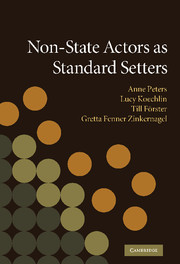Book contents
- Frontmatter
- Contents
- List of figures
- List of tables
- List of contributors
- Acknowledgements
- List of abbreviations
- Preface
- 1 Non-state actors as standard setters: framing the issue in an interdisciplinary fashion
- PART I New actors and processes in contemporary standard setting
- PART II The legitimacy and accountability of actors and standards
- PART III The authority and effectiveness of actors and standards
- 13 Standard setting for capital movements: reasserting sovereignty over transnational actors?
- 14 Certification as a new private global forest governance system: the regulatory potential of the Forest Stewardship Council
- 15 Private standards in the North – effective norms for the South?
- 16 International corporate social responsibility standards: imposing or imitating business responsibility in Lithuania?
- 17 Legal pluralism under the influence of globalisation: a case study of child adoption in Tanzania
- 18 Towards non-state actors as effective, legitimate, and accountable standard setters
- Index
- References
17 - Legal pluralism under the influence of globalisation: a case study of child adoption in Tanzania
from PART III - The authority and effectiveness of actors and standards
Published online by Cambridge University Press: 06 January 2010
- Frontmatter
- Contents
- List of figures
- List of tables
- List of contributors
- Acknowledgements
- List of abbreviations
- Preface
- 1 Non-state actors as standard setters: framing the issue in an interdisciplinary fashion
- PART I New actors and processes in contemporary standard setting
- PART II The legitimacy and accountability of actors and standards
- PART III The authority and effectiveness of actors and standards
- 13 Standard setting for capital movements: reasserting sovereignty over transnational actors?
- 14 Certification as a new private global forest governance system: the regulatory potential of the Forest Stewardship Council
- 15 Private standards in the North – effective norms for the South?
- 16 International corporate social responsibility standards: imposing or imitating business responsibility in Lithuania?
- 17 Legal pluralism under the influence of globalisation: a case study of child adoption in Tanzania
- 18 Towards non-state actors as effective, legitimate, and accountable standard setters
- Index
- References
Summary
Introduction
Family law in Tanzania, like in many other African countries, is strongly characterised by legal pluralism. State law, customary laws and religious laws exist side by side. Under the influence of globalisation, particularly the increasing international mobility of people, processes of further legal pluralisation can be observed. This chapter analyses such pluralisation processes in cases of child adoption in Tanzania.
Under African customary laws, the role of parent is not only to be played by the child's parents but also by other relatives, such as aunts, uncles, elder siblings, or grandparents. Until recently, formal child adoption under state law was quite uncommon among Tanzanians because they did not seem to see a need for it. However, the increase in international migration and the requirements of foreign immigration laws are effecting a change. Under many immigration laws, adults are only allowed to immigrate with children who are their own, in the sense of being part of the adults' nuclear family. This would normally include children who have been formally adopted, but it would exclude children who are looked after by a relative under customary law. If such relatives wish to live and work in a foreign country, they often will only obtain the necessary visa and residence permit for the child under their care if they formalise the customary care and adopt the child under state law.
- Type
- Chapter
- Information
- Non-State Actors as Standard Setters , pp. 465 - 491Publisher: Cambridge University PressPrint publication year: 2009
References
- 1
- Cited by



